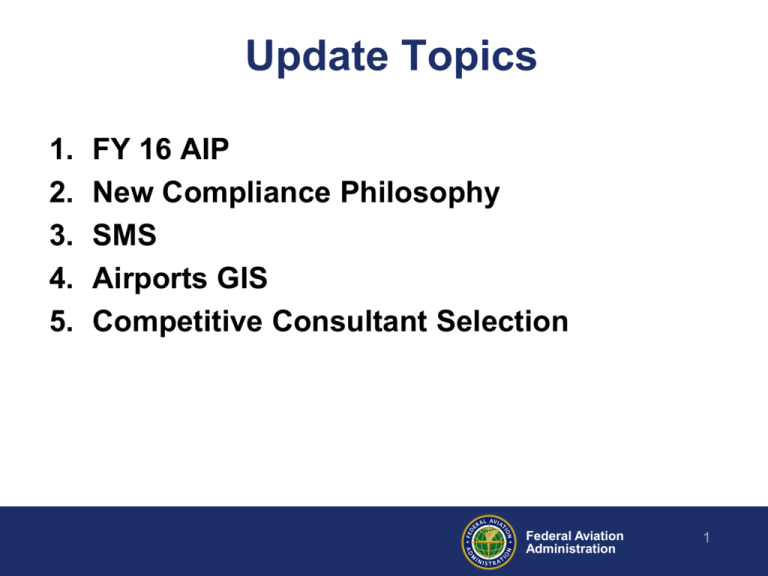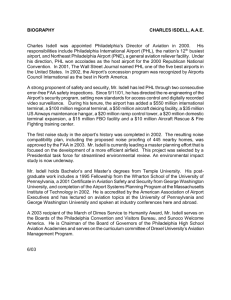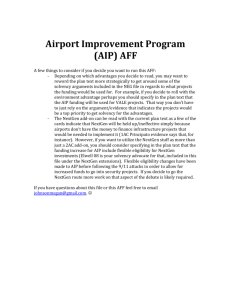Airports Update 20151029 Final-2
advertisement

Update Topics 1. 2. 3. 4. 5. FY 16 AIP New Compliance Philosophy SMS Airports GIS Competitive Consultant Selection Federal Aviation Administration 1 FY16 AIP Highlights • What does the Airport and Airway Extension Act of 2015 (the Extension) through March 31, 2016, and the Continuing Resolution through December 11, 2015 mean for ARP? The Extension provides the authority to collect aviation taxes for deposit into the Airport and Airway Trust Fund (Trust Fund), and to expend money from the Trust Fund. Without these authorities, we could not operate. The Extension allows ARP to continue to pay our employees so they can continue to provide oversight of all our ARP programs, in particular AIP. The Extension allows ARP to continue to make payments on our 5,407 open grants. ARP averages payments on existing grants of over $3 billion per year. During the 1st quarter of FY16 alone, ARP anticipates making payments on existing grants of about $1 billion, mainly reimbursing airport sponsors for costs incurred during the busy 2015 summer airport construction season. Federal Aviation Administration 2 FY16 AIP Highlights (Cont) The Extension also provides FAA contract authority to obligate new grants from the $1.675 billion, or 50% of the $3.35 billion. ARP will be in a position to issue our first grants at the beginning of the calendar year in January as airport sponsors are now getting 2016 projects ready for grant applications. Our Regions and ADOs are working with the airport sponsors to complete the many pre-grant requirements, such as updating their ALPs, gaining environmental approval, and completing airspace reviews. The CR will keep the rest of the FAA offices open and running through December 11. Federal Aviation Administration 3 FAA’s Compliance Philosophy • When deviations from regulatory standards do occur, the FAA’s goal is to use the most effective means to return an individual or entity that holds a FAA certificate, approval, authorization, or license to full compliance to prevent reoccurrence. • In 2015, FAA provided clarification to ensure all agency compliance and enforcement programs follow the same philosophy. • This shared philosophy is one that FAA Airports Division has embraced for many years which first focuses on education, training and awareness to remediate deviations and instances of non-compliance in most cases. Federal Aviation Administration 4 FAA’s Compliance Philosophy • In situations of repeated, intentional or reckless deviations from regulatory standards, FAA requires and must take strong enforcement stance when those deviations pose an unacceptable risk to safety. • Examples where strong enforcement action is necessary include: – Failing to ensure safety personnel (i.e. ARFF, Operations) are properly trained. – Failing to maintain airport surfaces in safe conditions. – Failures to provide sufficient and qualified personnel to ensure safety oversight. – Falsification of safety training records. Federal Aviation Administration 5 Safety Management Systems (SMS) • June 1, 2016, all (7) Small Hub Airports (MLI, MSN, FNT, CAK, GRR, DAY, FSD) are required to perform safety assessments for projects and application actions: – – – – – Submittal of revised ALPs for approval Airspace determinations Part 150 Noise compatibility programs FAA approval for a Modification of Standards (MOS) Final FAA approval of new and updated airport planning, design or construction standards. • Planned Outreach in January 2016 – Online Meeting / Webinars with each small hub airport, their consultants and the State Aviation agencies to discuss the small hub SMS implementation for June 1, 2016. • Supplemental Notice of Proposed Rule Making (SNPRM) for SMS is currently under review with the OMB. At this time we cannot comment on release of the notice or what may be contained in the notice. Federal Aviation Administration 6 Airports GIS Update • AC 150/5300-18C Published on 9/30/15 – Updates Table 2-1, Survey Requirements Matrix – Majority of Updates focus on aligning data format with the ATO NAVLean program – Updates to Airports GIS • System currently being updated to accept data in the -18C format • eALP Module being updated to accommodate new data format • Developing capability to download -18B data currently in Airports GIS in the -18C format • AC 150/5300-19 “Airport Data and Information Program” Published on 9/30/15 – Was briefly published on the FAA Website then taken down – Continue using existing 5010 guidance for now • Imagery – Approximately 403 images are available for viewing in the Airports GIS System – Continue to have goal to upload legacy ALPs Federal Aviation Administration 7 Airports GIS Update • As we enter FY 2016, AGIS data collection / submission is required by the Airports Geographical Information System (Airports GIS) Transition Policy for Non-Safety Critical Projects (8/23/12) for: – All projects that include “safety-critical” data (as defined in Section 4.3 [page 4-4] of the updated -18C); – All projects at Part 139 airports and airports with an Airport Traffic Control Tower (ATCT); – Most Master Plan updates at the remaining NPIAS airports (outside of Part 139 and Towered airports); – Most projects that require an update to the Airport Layout Plan (ALP) at the remaining NPIAS airports; – Many projects containing non-“safety-critical” features at the remaining NPIAS airports. Federal Aviation Administration 8 Title 49 CFR Part 18.36 2 CFR Part 200 Establishes uniform administrative rules for Federal grants. https://cfo.gov/cofar/ Federal Aviation Administration 9 • AC provides guidance to assist Sponsor to be compliance with the procurement requirements of §200.317-§200.326. • Conformance with the standards of AC 150/5100-14 is a condition of AIP eligibility. Federal Aviation Administration 10 AC 150/5100-14E Competition An unfair competitive advantage may exist when one firm has access to source selection information (project information) that competing firms do not have similar access to. Federal Aviation Administration 11 AC 150/5100-14E Update on Competition • Restrictions: Entities that develop or draft specifications, requirements, statements of work, invitations for bids, or requests for proposals must be excluded from competing for such procurements. • Exceptions: There are select situations where an unfair competitive advantage can be mitigated or neutralized. Federal Aviation Administration 12 AC 150/5100-14E Update on Competition • A firm under contract for both planning and follow-on design services is in a position to unduly influence the establishment of development objectives to their benefit. (i.e. loss of objectivity and transparency) • Conducting separately for Planning (Section 1.4.1) and design efforts (1.4.2) is a way to mitigate the perceived “unfair competitive advantage” that the firm completing the planning may have when competing the follow on implementation. Federal Aviation Administration 13 AC 150/5100-14E Update on Competition • Can a engineering firm complete the Cat-EX documentation for a design project? Yes, in most situations – Preparation of Cat-Ex documentation is a project formulation action that does not put the firm in a position to unduly influence the development objective to their benefit – This assumes project is well defined at the time of the RFQ such that project specifics would be known to competing parties. Federal Aviation Administration 14 AC 150/5100-14E Update on Competition • Does development of the ACIP exclude a firm from proposing on work? Not in all cases. Refer to Section 2.2.5 for examples on when a unfair competitive advantage could occur. • Do sponsors need to reselect for all AIP funded projects in FY 2016? Not in all cases. However, the sponsor needs to make a determination that the AIP funded work being completed does not have the potential for an “unfair competitive advantage”. Federal Aviation Administration 15 AC 150/5100-14E Update on Competition Questions to Ask on Current Selections • Were the professional services for AIP funded project procured in accordance with AC 150/5100-14E? (Competitively selected for the specific project, within the term of the original selection timeframe?) If No, reselection is necessary. • Did the firm providing professional services prepare, develop or draft specifications, requirements, statements of work, invitations for bids, or requests for proposals? If Yes, reselection is necessary. Federal Aviation Administration 16 AC 150/5100-14E Update on Competition Questions to Ask on Current Selections • Are the professional services being provided the result of a planning effort that the same firm prepared under the same contract? If contract is not executed, reselection may be necessary if the follow-on design results in a unfair competitive advantage. For example, if a firm completing design work established the project objectives in the planning and environmental stage under the same contract, there is a perceived lack of objectivity and transparency that adversely affects the full and open competition aspect. Federal Aviation Administration 17 Next Steps Internal Desk Guide – Early Nov 2015 The desk reference will serve as a valuable resource for FAA ADOs when responding to questions and requests for clarification from external stakeholders. The guide will also foster uniform and consistent implementation of 2 CFR Part 200 across FAA regions. 2 CFR 200 Contact: Carlton Lambiasi/Richard Kula – AGL Regional Office Federal Aviation Administration 18





